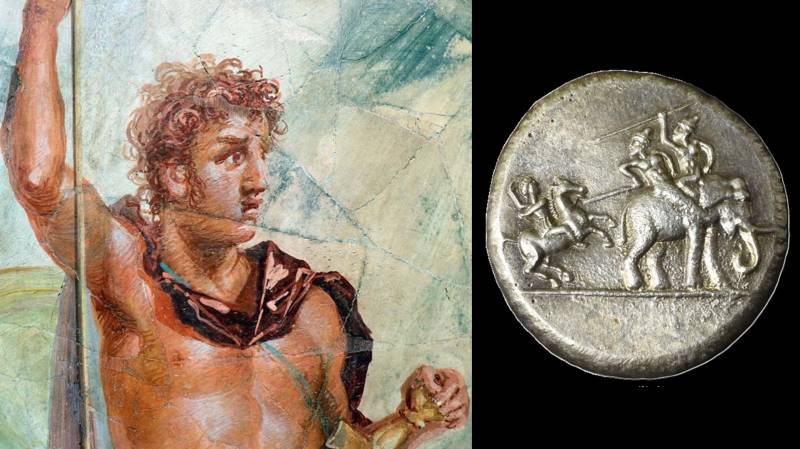
Note: Click here for the first part in this series
Revolt in the Macedonian Army on the Hyphasis
Alexander himself with his army was advancing towards the Hyphasis (Beas) now. This was the time when Alexander obtained information about the Ganges and the strength of the army kept by Agrammes, king of the Prasians. He was the last ruler of the Nanda Empire whose capital was at Magadha. So, Alexander made a speech to his soldiers to induce them to advance to the Ganges.
On behalf of Macedonian army, Coenus made a speech for returning back to home – much to Alexander’s disappointment. Alexander was forced to turn back by his exhausted army, who refused to journey further into India fearing, future hardships. The army had been exhausted due to years of journeys, fatigue, heat, diseases, cold weather, wild beasts, and lack of supplies. They missed their families, relatives and friends now.
Alexander erects altars on the banks of the Hyphasis
We are told that Alexander built altars on the banks of the Hyphasis (Beas) to mark the limits of his advance, recrossed the Hydraotes (Ravi) and Akesines (Chenab), and regained the Hydaspes (Jhelum).
Arrian writes, “Then they shouted, as a mixed multitude would shout when rejoicing, and many of them shed tears. Some of them even approached the royal pavilion, and invoked many blessings on Alexander, because by them and them only he permit himself to be vanquished. He then divided the army into brigades, which he ordered to prepare 12 altars to equal in height the highest military towers, and to exceed them in point of breadth, to serve as thank offerings to the gods who had led him so far as a conqueror, and also as a memorial of his own labours. When the altars had been constructed, he offered sacrifice upon them with the customary rites, and celebrated a gymnastic and equestrian contest. Having thereafter committed all the country west of the river Hyphasis to the government of Poros, he marched back to the Hydraotes.” (128)
Describing Alexander’s Altars on Hyphasis River, Philostratus (d 240 AD), writes in The Life of Apollonius of Tyana (Chapter XLIII):
“And having crossed the River Hydraotes and passed by several tribes, they reached the Hyphasis and 30 stades away from this they came on altars bearing this inscription: ‘To Father Ammon and Heracles his brother, and to Athena Providence and to Zeus of Olympus and to the Cabeiri of Samothrace, and to the Indian Sun and to the Delphian Apollo.’”
We are told that a brass column was also erected, and inscribed as follows:
“Alexander stayed his steps at this point.”
In 1922, these altars & inscriptions became the reason of the discovery of Mohenjo-Daro, a 5,000-year-old city of the Indus Valley Civilisation.
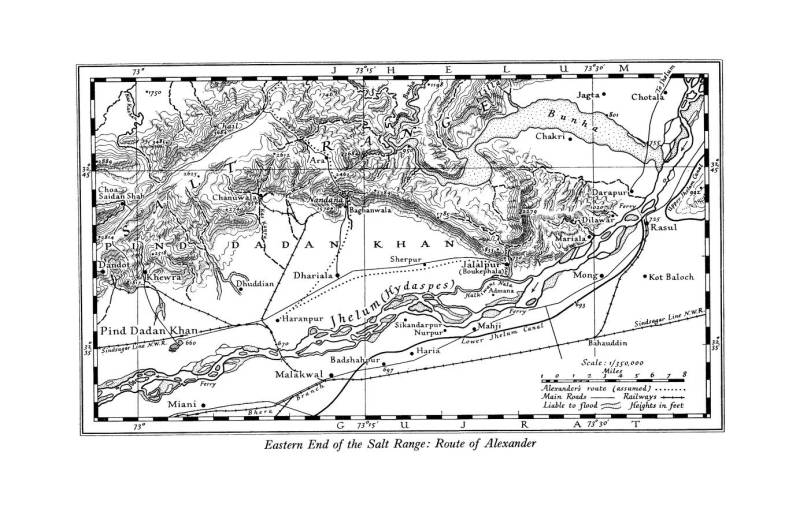
The Akesines, where Alexander’s general Coenus died
Coenus was one of the ablest and most faithful generals of Alexander in his eastern expedition. And he was the first who had the boldness strongly to urge the necessity of returning. The king was obliged to follow his advice.
But a short time afterwards, when the Macedonian army had actually started its return, Coenus died of an illness in Summer 326 BC. Alexander honoured him a splendid burial. He lamented his death. Some believe that Coenus was poisoned due to his opposition to Alexander.
King Sophytes entertained Alexander with splendour on the banks of the Hydaspes (Jhelum). The strength and tenacity of his great hunting dogs, of which he gave an exhibition, was what impressed the Europeans more than anything else
Arrian in Chapter II, “Description of the Voyage down the Hydaspes,” notes the following:
“At this time Koinos, who was one of Alexander’s faithful companions, took ill and died, and his master buried him with all the magnificence circumstances allowed. He then assembled the companions and all the ambassadors of the Indians who had come to him, and in their presence appointed Poros king of all the Indian territories already subjugated, seven nations in all, containing more than 2,000 cities”.(133)
Alexander invades the territories of the Malloi and their strongholds
Ancient Roman historian Quintus Curtius Rufus states:
“The fleet which he had ordered to be built was now riding in the stream ready for service. Memnon also had meanwhile brought from Thrace a reinforcement of 5,000 cavalry, together with 7,000 infantry sent by Harpalus. He also brought 25,000 suits of armour inlaid with silver and gold, and these Alexander distributed to the troops, commanding the old suits to be burned. Designing now to make for the ocean with a thousand (1,000) ships, he left Porus and Taxiles, the Indian kings who had been disagreeing and raking up old feuds, in friendly relations with each other, strengthened by a marriage alliance; and as they had done their utmost to help him forward with the building of his fleet, he confirmed each in his sovereignty”. (230)
Alexander divided his army in three divisions. Krateros must have commanded a division of the infantry and cavalry along the right bank of the Hydaspes (Jhelum) through today’s Sindh Sagar Thal which lies in district Dera Ghazi Khan. Meanwhile, Hephaistion on the opposite bank advanced in command of the largest and best division of the army, to which the elephants, now 200 in number were attached. These generals were instructed by Alexander to march with all possible speed to reach the Palace of Sopeithes.
King Sophytes: his beauty, stature and hospitality
After the submission of the Adrestai and Kathians, Alexander entered the Kingdom of Sophytes or Saubhutu. Arrian writes that his dominions lay along the banks of the Hydaspes River. Strabo believes his territory was the Salt Range called Oromenus by Pliny. Sophytes voluntarily surrendered to Alexander. Arrian calls him Sopeithes, while Curtius calls him Sophitis. Some coins found bear his name in Greek letters as Sophytes.
According to The Cambridge History of India (Vol 4, 1968):
“The first Indian king whose name occurs on a coin is Sophytes (Saubhuti), a contemporary of Alexander. In later days, he struck coins with his name in Greek as Sophytes. These coins depict the head of a warrior, wearing close fitting helmet, wreathed with olive, a border of dots, Caduceus and border of dots.”
According to Cunningham, the capital city of King Sophytes must have been Old Bhera (District Sargodha), which was three days’ march from Nikaia. Alexander reached here with his fleet after three days.
Quintus Curtius Rufus writes that King Sophytes along with his two grown-up sons issued from his capital to welcome Alexander. He was distinguished by his tall and handsome figure. His royal robe was adorned with pearls. His sandals were of gold and decorated with precious stones (220). It is considered that Alexander’s forces sailed down jointly from Bhera towards Multan.
PHL Eggermont has briefly discussed the Palace of King Sophytes in his book entitled Alexander’s Campaign in Southern Punjab (1993).
King Sophytes entertained Alexander with splendour. The strength and tenacity of his great hunting dogs, of which he gave an exhibition, was what impressed the Europeans more than anything else.
Diodoros, giving details about this king and his people, writes: “He next warred against the cities that were subject to the sway of Sophytes. These were governed by laws in the highest degree salutary, for while in other respects their political system was one to admire, beauty was held among them in the highest estimation. For this reason a discrimination between the children born to them is made at the stage of infancy, when those that are perfect in their limbs and features, and have constitutions which promise a combination of strength and beauty, are allowed to be reared, while those that have any bodily defect are condemned to be destroyed as not worth the rearing. They make their marriages also in accordance with this principle, for in selecting a bride they care nothing whether she has a dowry and a handsome fortune besides, but look only to her beauty and other advantages of the outward person. It follows that the inhabitants of these cities are generally held in higher estimation than the rest of their countrymen. Their king Sopeithes, who was admired by all for his beauty and his stature, which exceeded four cubits, came forth from the city where his palace was, and on surrendering himself and his kingdom to Alexander was reinstated in his authority by the clemency of the conqueror. Sopeithes with the utmost cordiality feasted the whole army in splendid style for several days.” (279 and 280)
In short, King Sophytes received Alexander with great hospitality and showed him a dog-and-lion fight in his capital city. Phillippos, the satrap of Bactrians, received orders to follow Alexander. The command of the whole naval squadron was entrusted to Nearchos, while the pilot of Alexander’s own ship was Onesikritos. There were a total number of 2,000 galleys, crafts and boats.
Alexander sacrificed to the gods and to the River Akesines (Chenab) as the seers had directed. The voyage started with the sound of the trumpet. When the Indians who had submitted to Alexander heard the shouts of the rowers, they ran down to the edge of the river and followed the fleet, singing their “wild” native chaunts.
Now, Alexander reached the turbulent confluence of the Hydaspes (Jhelum) and Akesines (Chenab). Many of the ships were damaged and sunk during this voyage. Meanwhile, Alexander made himself an inroad into the territories of the barbarians who refused to submit. These barbarians were probably the Siboi, Sibai or Sibi tribesmen.
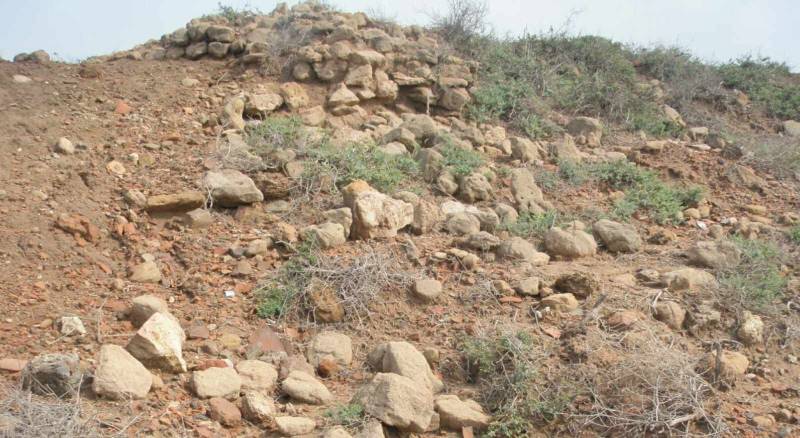
Submission of the Siboi, Agalassians, Malloi and Oxydrakai tribes
After crossing from Bucephalus, Nikaia and Bhera, Alexander passed through modern day Kot Kamalia, Tulamba, Atari and Multan. During this campaign he invaded the Siboi and Agalassian tribes.
Describing Alexander’s campaign in the Sibai, Quintus Curtius Rufus writes:
“Thus he came at length into the country where the river Hydaspes falls into Akesines and thence flows down to the territories of the Sibi”. (232)
Who were the people of Siboi? Rufus adds, “These people allege that their ancestors belonged to the army of Hercules, and that being left behind on account of sickness had possessed themselves of the seats which their posterity now occupied. They dressed themselves with the skins of wild beasts and had clubs for their weapons”.(232)
According to The Geography of Strabo, Alexander saw crocodiles in the Hydaspes (Jhelum) and the Akesines (Chenab). He thought that he had discovered the source of the Nile River, and was about to equip a fleet with the intension of sailing by this river to Egypt.
Alexander attacked Siboi. Nearly 40,000 foot soldiers had come up along the river to oppose Alexander’s landing. He took their capital town by an assault. All people were compelled to surrender. Those who were of military age were put to the sword, and the rest were sold as slaves.
Alexander then took another town, but the defenders resisted gallantly. Many of the Macedonians were killed. Alexander trapped the inhabitants, but they, despairing of safety, set fire to their houses, and cast themselves along with their wives and children into the flames.
Now, Alexander came into the dominions of the Sudracae and Malli, who were at war with each other. They united together in presence of the common danger. Their army consisted of 90,000 foot soldiers, together with 10,000 cavalry and 900 war chariots. They had selected their head from the Sudracae nation. This experienced general encamped at the foot of mountain. He also ordered his army to kindle fires to terrify Macedonians.
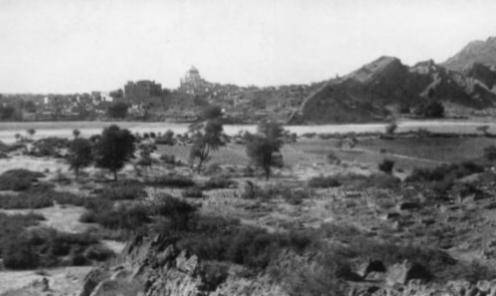
Alexander wounded by an Indian arrow
Alexander attacked the Sudracae capital with force but his soothsayer Demophon warned him not to undertake the siege and postpone it for a while, because omens had indicated that his life would be in danger. Nevertheless, Alexander ordered the scaling ladders to be applied to the walls. While others were hesitating to mount them, he himself scaled the ramparts.
The Indians were shooting arrows from all directions towards Alexander, who was clinging to the edge of a rampart with his sword and shield. Alexander was severely wounded by a two-cubit-long arrow shot by a defending archer.
The archer ran forward to kill Alexander but suddenly there came Peucestas for his help. As Alexander bled badly, and he was exhausted, so he fell over on his shield. He was about to die from that arrow wound. Then came up Timaeus, Leonnatus and Aristonus to save their king. All the Indians now ran in crowds to attack the king and his soldiers.
In the meantime, a rumour spread that the king had fallen. Seeing this, the Macedonians broke down the wall with their pickaxes and rushed into the city. They did not spare old men, women and children.
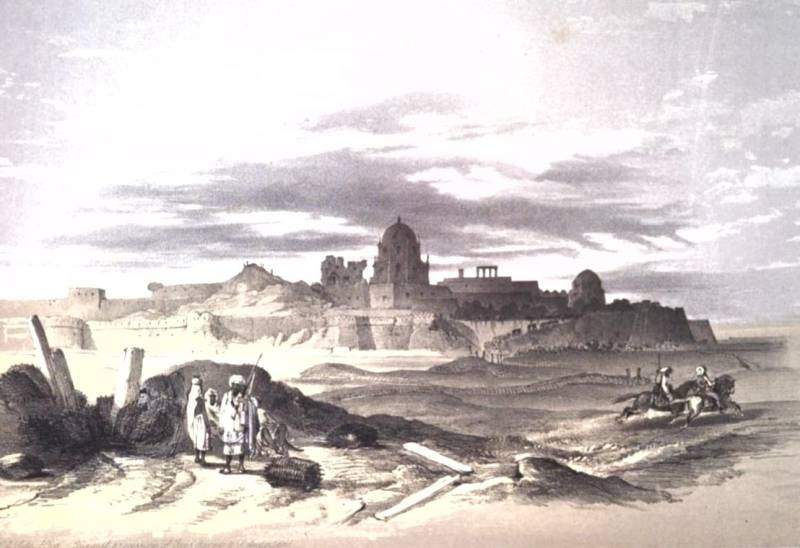
Alexander was taken into a tent where the surgeons had cut off the wooden shaft of the arrow which had pierced him, taking care not to stir its point. Critobulus, who was famous for his surgical work, extracted the arrow from Alexander’s body. Everyone thought that Alexander was dying, so they started lamentations. The bleeding at last stopped and Alexander recovered from the wound.
Today, the descendents of these Malloi people are called Malhi. They live in Multan and Layyah regions.
One day, an embassy from the Sudracae and Malli arrived to submit, with 150 powerful leaders for a treaty. Alexander selected the 1,000 best and tallest men from the Indians together with 500 chariots. He appointed Philippo as satrap of the Sudracae and Malli nations. Later on, he sent back hostages but he kept the chariots.
Alexander entertained his army and the embassy at a sumptuous banquet. This was the time when a revolt arose in Bactria. Alexander resolved the affair of Biton and Boxus of Margiana.
Now, Predikkas came to Alexander with his force after subjugating the Abastanoi (Sambastai) tribe. There he also received the submission of the Xathroi (Khatri) and Ossadioi Indian tribes. At this time, Oxyartes, the father of Alexander’s Bactrian wife Roxana, arrived. Alexander bestowed him the satrapy of Parapamisadai. He also appointed Oxyartes and Peithon satraps of the country from the Akesines and Indus to the sea, together with the whole seaboard of India. Alexander also subjugated the Sodrae, Massani, Abastanes and the Xathri tribes.
He must have crossed from the modern districts of Jhelum, Chakwal, Mianwali, Khushab, Dera Ghazi Khan, Bhakkar, Layyah, Kot Adu, Muzaffargarh, and Rajanpur. It is told that a Magsi woman from Village Nawa Kot, Tehsil Jabara, District Layyah found a treasure trove of Indo-Greek coins from the desert in 1985. Today, these coins are displayed in Thal Museum Layyah owned by Mian Imdad Hussain Leekhi and his family.
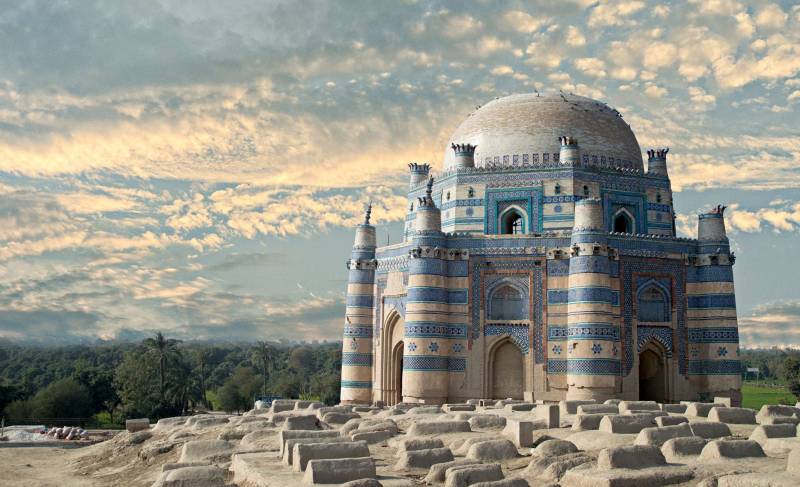
Foundation of Alexandria at the junction of Akesines and Indus Rivers
We are told by The Hellenistic Settlements in the East from Armenia and Mesopotamia to Bactria and India (2013):
“According to Arrian (6.15.2) in 325 B.C. Alexander ordered Philippos “to found a city there just at the meeting of the two rivers ie the Akesines (modern Chenab) and the Indus Rivers…and dockyards to be built”. It was initially populated by 10,000 settlers. The existence of this settlement has been questioned. Assuming it was built, we do not know the exact location”.
This newly built city was also called Alexandria of Sogdoi. Alexander built new ship stations, and refitted his damaged ships here.
Sir Alexander Cunningham and Eggermont suggested that the settlement was located at Uch in southern Punjab. Therefore the town of Sogdia was identical with Alexandria Uch, which is 112 kilometres in the south southeast of Multan. After the foundation of Alexandria and appointment of Satraps, Alexander started his final voyage down the Indus to the dominions of Mousikanus.

